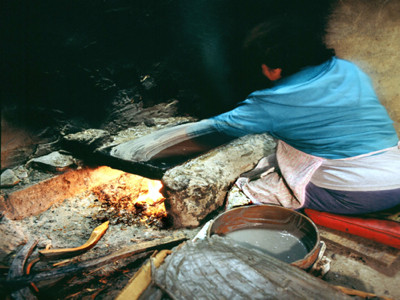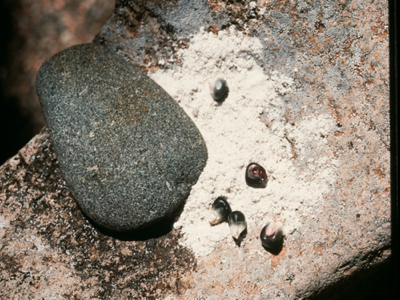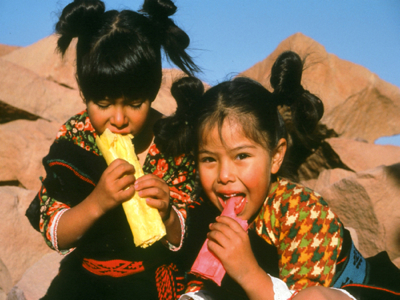 |
Canku Ota
|
 |
|
(Many Paths)
|
||
|
An Online Newsletter
Celebrating Native America
|
||
|
April 2014 - Volume
12 Number 4
|
||
|
|
||
|
Piki Bread
|
||
|
by Lois Ellen Frank
|
||
 Piki
bread is one of the Southwest regions’ precious gifts, a sacred
and delicious tradition now recognized by Slow Foods Ark of Taste.
The making of Piki is an art and a ritual taking years of practice
to master, and the knowledge, along with the heirloom stone used to
make the traditional bread, is passed down through generations from
mother to daughter. In the past, a young woman was required to demonstrate
that she had mastered the art of making Piki before she could be considered
a suitable bride. Piki
bread is one of the Southwest regions’ precious gifts, a sacred
and delicious tradition now recognized by Slow Foods Ark of Taste.
The making of Piki is an art and a ritual taking years of practice
to master, and the knowledge, along with the heirloom stone used to
make the traditional bread, is passed down through generations from
mother to daughter. In the past, a young woman was required to demonstrate
that she had mastered the art of making Piki before she could be considered
a suitable bride.
Today, there are fewer women mastering the art of making Piki, but it is women who still maintain the tradition of this paper-thin cornbread. Traditionally used in ceremonies, it is extremely nutritious, making it a staple food in the diets of the communities where it originated, and is considered to be one of the original Indian breads. The word Piki is Hopi in origin, called paper bread in Jemez Pueblo, and is still made on some of the New Mexico Pueblos. The blue cornmeal batter is baked in large tissue-paper-thin sheets; occasionally, white, yellow, or red corn is used to make Piki, but only for special dances.
Piki can often be found at some of the booths at the Indian Market in Santa Fe, from some of the same women who sell traditional Native pottery, baskets and jewelry. If the opportunity arises, I recommend that you buy a roll or two and taste this ancient and sacred tradition, as demand helps to keep traditions alive. It can also be found at the Hopi Cultural Center in Second Mesa, Arizona, and at local Native community festivals. To reach Clayton Brascoupe and to find out more about Piki workshops, contact him at the Native American Farmer’s Association website: www.tnafa.org.
Slow Food Ark of Taste The Ark is an international catalog of foods that are threatened by industrial standardization, the regulations of large-scale distribution and environmental damage. In an effort to cultivate consumer demand—key to agricultural conservation—only the best tasting endangered foods make it onto the Ark. Since 1996, more than 800 products from over 50 countries have been added to the international Ark of Taste. The US Ark of Taste profiles over 200 rare regional foods, and is a tool that helps farmers, ranchers, fishers, chefs, retail grocers, educators and consumers celebrate our country's diverse biological, cultural and culinary heritage. To qualify for the US Ark of Taste, food products must be:
Product categories include vegetables, fruits and berries, nuts, cereals, cheeses, fish, shellfish, game, livestock, poultry, beverages, honey, spices, syrups, vinegars, and more. The Slow Food USA biodiversity committee evaluates Ark of Taste nominations on an on-going basis. To find out more about Ark of Taste and other Slow Food initiatives, visit www.slowfoodusa.org
Traditional
Native American Farmers Association (TNAFA) Slow
Food USA Indian
Pueblo Cultural Center |
|
|
||
|
|
||
| Canku Ota is a free Newsletter celebrating Native America, its traditions and accomplishments . We do not provide subscriber or visitor names to anyone. Some articles presented in Canku Ota may contain copyright material. We have received appropriate permissions for republishing any articles. Material appearing here is distributed without profit or monetary gain to those who have expressed an interest. This is in accordance with Title 17 U.S.C. Section 107. | ||
|
Canku Ota is a copyright ©
2000 - 2014 of Vicki Williams Barry and Paul Barry.
|
||
 |
 |
|
|
The "Canku
Ota - A Newsletter Celebrating Native America" web site and
its design is the
|
||
|
Copyright ©
1999 - 2014 of Paul C. Barry.
|
||
|
All Rights Reserved.
|
||
 Piki
is traditionally made on a Piki stone, housed in a special house
called the Piki house. The stone is a large, flat, smooth stone
that is approximately four to six inches thick by 24 to 28 inches
long and about 18 inches wide. The stone is usually elevated - raised
on four legs or two longer brackets sometimes made out of mud, so
that wood, usually cedar, can be burned underneath to heat the stone
and bake the bread. Piki stones take a long time to prepare and
season, watermelon seeds or other traditional fats like bone marrow
or cooked sheep brains are often used to oil the heirloom stones.
Piki batter is pancake like in consistency, and prepared with just
three ingredients: a very finely ground blue cornmeal, usually grown
and harvested in the community, culinary ash, and water. The mixing
together of the cornmeal and culinary ash creates nixtamilization,
a process that increases the availability of nutrients in the corn.
The corn meal is blended with water to produce a light batter that
the women spread thinly on a hot, well-seasoned stone with their
bare hands. The Piki maker dips her hand in the batter and then
rubs it onto the hot stone, continuing to add strokes of batter
until a large sheet, almost the size of the stone, is formed. This
thin dough is then cooked until it dries, and then pulled off the
stone in one large sheet. Another layer of Piki is then laid down
onto the stone and the previous sheet placed on top, until it softens.
The two layers are then folded several times, and then rolled to
about the size of a large ear of corn. The resulting bread is beautiful
and light, wafer-thin and crispy, light blue to gray in color with
an earthy, smoky, mildly sweet corn flavor.
Piki
is traditionally made on a Piki stone, housed in a special house
called the Piki house. The stone is a large, flat, smooth stone
that is approximately four to six inches thick by 24 to 28 inches
long and about 18 inches wide. The stone is usually elevated - raised
on four legs or two longer brackets sometimes made out of mud, so
that wood, usually cedar, can be burned underneath to heat the stone
and bake the bread. Piki stones take a long time to prepare and
season, watermelon seeds or other traditional fats like bone marrow
or cooked sheep brains are often used to oil the heirloom stones.
Piki batter is pancake like in consistency, and prepared with just
three ingredients: a very finely ground blue cornmeal, usually grown
and harvested in the community, culinary ash, and water. The mixing
together of the cornmeal and culinary ash creates nixtamilization,
a process that increases the availability of nutrients in the corn.
The corn meal is blended with water to produce a light batter that
the women spread thinly on a hot, well-seasoned stone with their
bare hands. The Piki maker dips her hand in the batter and then
rubs it onto the hot stone, continuing to add strokes of batter
until a large sheet, almost the size of the stone, is formed. This
thin dough is then cooked until it dries, and then pulled off the
stone in one large sheet. Another layer of Piki is then laid down
onto the stone and the previous sheet placed on top, until it softens.
The two layers are then folded several times, and then rolled to
about the size of a large ear of corn. The resulting bread is beautiful
and light, wafer-thin and crispy, light blue to gray in color with
an earthy, smoky, mildly sweet corn flavor.  Texturally,
it is unlike anything I have ever tasted. Each time I eat Piki,
I am reminded that the preparation and eating of this ancient bread
is still sacred to the Native communities. When I first watched
Genevieve Kaursgowva from Hotevilla, Arizona make Piki in her Piki
house on the Hopi reservation, I was amazed at how effortless she
made the process look. Inspired, and with Genevieve’s encouragement,
I decided to try my hand at this ancient tradition. Despite my effort
to spread the batter smoothly across the length of the stone as
I had watched Genevieve do so effortlessly, my batter caught on
one end of the stone while my hand burned as it stuck to the hot
stone. Genevieve coaxed me on, “Learning to make Piki takes
time and patience. The secret is to get just enough batter on your
fingers and then glide your battered fingers over the face of the
stone, with the thinnest layer of batter separating your fingers
from the stone.” We laughed and I tried again, with not much
more luck.
Texturally,
it is unlike anything I have ever tasted. Each time I eat Piki,
I am reminded that the preparation and eating of this ancient bread
is still sacred to the Native communities. When I first watched
Genevieve Kaursgowva from Hotevilla, Arizona make Piki in her Piki
house on the Hopi reservation, I was amazed at how effortless she
made the process look. Inspired, and with Genevieve’s encouragement,
I decided to try my hand at this ancient tradition. Despite my effort
to spread the batter smoothly across the length of the stone as
I had watched Genevieve do so effortlessly, my batter caught on
one end of the stone while my hand burned as it stuck to the hot
stone. Genevieve coaxed me on, “Learning to make Piki takes
time and patience. The secret is to get just enough batter on your
fingers and then glide your battered fingers over the face of the
stone, with the thinnest layer of batter separating your fingers
from the stone.” We laughed and I tried again, with not much
more luck.  At
the Tesuque Pueblo here in New Mexico, all of Clayton Brascoupe’s
daughters, Wenona Nutima, Elaine Barraza, Povi Juarez and Phoye
Tsay Rivera know how to make Piki. This year his ten-year-old granddaughter
learned to make the traditional Piki. Clayton and his daughters
are keeping the tradition alive, and do educational workshops around
Piki. Both Wenona and Elaine gave Piki demonstrations at the Native
Foods and Wellness program at the Indian Pueblo Cultural Center
in 2007.
At
the Tesuque Pueblo here in New Mexico, all of Clayton Brascoupe’s
daughters, Wenona Nutima, Elaine Barraza, Povi Juarez and Phoye
Tsay Rivera know how to make Piki. This year his ten-year-old granddaughter
learned to make the traditional Piki. Clayton and his daughters
are keeping the tradition alive, and do educational workshops around
Piki. Both Wenona and Elaine gave Piki demonstrations at the Native
Foods and Wellness program at the Indian Pueblo Cultural Center
in 2007.